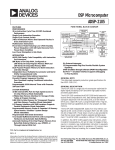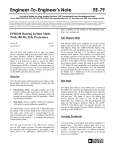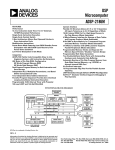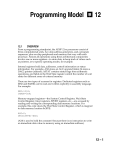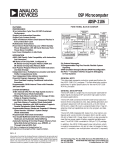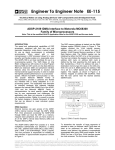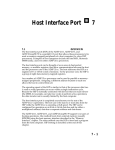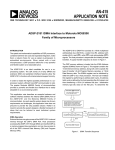Download ADSP-2100 Family User`s Manual, DMA Ports
Transcript
DMA Ports 11.1 11 OVERVIEW The ADSP-2181 supports several DMA interfacing features: • Byte Memory & Byte Memory DMA (BDMA): this memory space can address up to 4M bytes. The byte memory interface supports booting from and runtime access to inexpensive 8-bit memories. The BDMA feature lets you define the number of memory locations the ADSP-2181 will transfer to/from internal memory in the background while continuing foreground processing. • Internal Direct Memory Access (IDMA) Port: this parallel port supports booting from and runtime access to host systems (for example, PC Bus Interface ASICs). The DMA feature of this port lets you transfer data to/from internal memory in the background while continuing foreground processing. These DMA transfers are accomplished internally by “cycle stealing,” in the same way as serial port autobuffering. This means that the ADSP-2181 uses internal bus cycles to transfer the data to and from memory. The stolen cycles will only occur at instruction cycle boundaries, i.e. not between cycles of a multiple-cycle instruction. See “IACK Acknowledge & DMA Cycle Stealing” at the end of this chapter for additional details. The ADSP-2181 uses a half-instruction-rate clock input from which it generates a full-instruction-rate internal clock. For example, from a 16.67 MHz clock input (CLKIN) the ADSP-2181 generates a 33.33 MHz instruction rate clock. All timing diagrams for the processor use the fullinstruction-rate output clock (CLKOUT) as a reference. Figure 11.1 shows an ADSP-2181 system and the interfaces to byte memory space and the IDMA port. 11 – 1 11 DMA Ports ADSP-2181 1/2x CLOCK or CRYSTAL CLKIN XTAL 14 ADDR13-0 A13-0 D 23-16 FL0-2 PF0-7 24 D15-8 DATA23-0 A0-A21 BYTE MEMORY DATA IRQ2 IRQE IRQL0 IRQL1 CS BMS A 10-0 ADDR D 23-8 SPORT 1 SERIAL DEVICE 2048 Locations IOMS IDMA PORT IRD IWR IS IAL IACK 16 IAD15-0 CS A 13-0 ADDR SPORT 0 SCLK0 RFS0 TFS0 DT0 DR0 SERIAL DEVICE SYSTEM INTERFACE or µCONTROLLER DATA SCLK1 RFS1 or IRQ0 TFS1 or IRQ1 DT1 or FO DR1 or FI I/O SPACE (PERIPHERALS) D23-0 PMS DMS CMS DATA OVERLAY MEMORY Two 8K PM Segments Two 8K DM Segments BR BG BGH PWD PWDACK Figure 11.1 ADSP-2181 System 11.2 BDMA PORT The ADSP-2181’s byte memory space is 8 bits wide and can address up to 4M bytes of program code or data. This memory space takes the place of the boot memory space found on other ADSP-2100 family processors. Unlike boot memory space, byte memory has read/write access through the ADSP-2181’s BDMA port. Each read/write to byte memory consists of data (on data bus lines 15:8) and address (on address bus lines 13:0 plus data lines 23:16). The 22-bit byte memory address lets you access up to 4M bytes of ROM or RAM. 11 – 2 DMA Ports 11 Byte memory space consists of 256 pages, each containing 16K x 8-bit wide locations. This memory can be written and read in four different formats: 24-bit, 16-bit, 8-bit MSB alignment, and 8-bit LSB alignment. To use byte memory for purposes other that boot loading, for example runtime access to bulk data storage, you must know the page (BMPAGE) that the code/data is stored on, the number of words (BWCOUNT) to read from that page, and the word format (BTYPE) of the data. Use the following procedure to prepare a runtime-accessible byte memory EPROM: • Develop the data/code to be accessed at runtime • Use the ADSP-2100 Family PROM Splitter utility to split the file into single page (or smaller) 16K x 8-bit-wide segments • Program these pages into your EPROM, noting the offset (page number) of each • Use these page numbers when doing BDMA accesses Note: For more information on the ADSP-2100 Family Development Software Tools, see the ADSP-2100 Family Assembler Tools & Simulator Manual and current software release note. When using BDMA for non-boot-loading transfers, a BDMA transfer begins when data is written to the BWCOUNT register and a BDMA interrupt is issued when the transfer is complete. The following restrictions apply to BDMA transfers: • The source or target of BDMA transfer is always internal program or data memory. The contents of the PMOVLAY and DMOVLAY registers do not influence BDMA source (or target selection). • Do not access the BEAD or BIAD registers during BDMA transfers. • Other external memory accesses (PM overlay, DM overlay, or I/O space) take precedence over BDMA port accesses. These accesses cannot occur at the same time because they also use the processor’s external bus. • Do not enter powerdown mode with the BDMA port active. For information on powerdown restrictions on BDMA port access, see the System Interface chapter of this manual. 11 – 3 11 DMA Ports 11.2.1 BDMA Port Functional Description The BDMA Port lets you load (and store) program instructions and data from (and to) byte memory with very low processor overhead. While the ADSP-2181 is executing program instructions, the BDMA port reads (or writes) code or data from (or to) byte memory—stealing one ADSP-2181 cycle per word when it needs to write to (or read from) internal memory. You can calculate BDMA transfer time from the formula: Number of PM or DM Words Number of Bytes per Word Number of Added Waitstates per Byte + 1 Cycle for Transfer + 1 Cycle for Internal + RD/WR Hold Offs If, for example, you wanted to transfer 100 24-bit program memory words through the BDMA port, assuming five waitstates and no hold offs, the operation would take 1900 cycles. This is shown in the following equation: 100 PM Words 3 Bytes per Word 5 Added Waitstates per Byte + 1 Cycle for Transfer + 1 Cycle for Internal RD/WR + 0 Hold Offs Hold offs for DMA transfers are defined in the section “DMA Cycle Stealing, DMA Hold Offs, and IACK Acknowledge” at the end of this chapter. 11.2.2 BDMA Control Registers A set of memory-mapped registers are used to setup and control transfers through the BDMA port. Figures 11.2 through 11.6 show these registers. The BDMA Internal Address Register (BIAD) lets you set the 14-bit internal memory starting address for a BDMA transfer. The BDMA External Address Register (BEAD) lets you set the 14-bit external memory starting address for a BDMA transfer. 11 – 4 DMA Ports 11 BDMA Internal Address 15 14 13 12 11 10 9 8 7 6 5 4 3 2 1 0 0 0 0 0 0 0 0 0 0 0 0 0 0 0 0 0 DM(0x3FE1) BIAD Figure 11.2 BDMA Internal Address Register BDMA External Address 15 14 13 12 11 10 9 8 7 6 5 4 3 2 1 0 0 0 0 0 0 0 0 0 0 0 0 0 0 0 0 0 DM(0x3FE2) BEAD Figure 11.3 BDMA External Address Register 11 – 5 11 DMA Ports BDMA Control 15 14 13 12 11 10 9 8 7 6 5 4 3 2 1 0 0 0 0 0 0 0 0 0 0 0 0 0 1 0 0 0 DM(0x3FE3) BTYPE (see table) BMPAGE BDIR 0 = load from BM 1 = store to BM BTYPE 00 01 10 11 Internal Memory Space PM DM DM DM Word Size 24 16 8 8 Alignment full full MSB LSB word word Figure 11.4 BDMA Control Register The BDMA Control Register lets you set: • • • • The BDMA Transfer Type (BTYPE) The BDMA Direction (BDIR) The BDMA Context Reset (BCR) The BDMA Page (BMPAGE) BTYPE can be: 00 01 10 10 24-bit Program Memory Words 16-bit Data Memory 8-bit bytes for Data Memory, MSB alignment 8-bit bytes for Data Memory, LSB alignment BDIR can be: 0 1 11 – 6 from Byte Memory to Byte Memory BCR 0 = run during BDMA 1 = halt during BDMA, context reset when done DMA Ports 11 BCR can be set to: 0 1 Allow program execution during BDMA Inhibit program execution during BDMA transfers and cause a context reset after transfer is complete BMPAGE lets you select the starting page for BDMA transfer. Note: Rebooting with BDMA Context Reset (BCR=1) is similar to a Powerup Context Reset. For more details on processor states during reset and reboot, see the System Interface chapter of this manual. The BWCOUNT register lets you start a BDMA transfer by writing the number of words for the transfer to this register. The count automatically decrements as the transfer proceeds. When the count is zero (i.e. transfer complete), the processor issues a BDMA interrupt. When MMAP and BMODE are set to zero on boot, a value of 32 (decimal) is written to this register directing the ADSP-2181 to load the first 32 locations of its internal program memory. Two useful control techniques using this register are: • Poll the BWCOUNT register to determine when the DMA transfer is complete (BWCOUNT=0), instead of waiting for the BDMA interrupt. • Abort the DMA operation by writing a 1 to the BWCOUNT register and poll to determine when the transfer is complete (BWCOUNT=0), instead of waiting for the BDMA interrupt. (Note that the DMA transfer is aborted, and cannot be resumed later.) BMWAIT consists of bits 12, 13, and 14 of the Programmable Flag & Composite Select Control Register. BMWAIT lets you select 0-7 waitstates (each equal to a single instruction cycle) to apply to each byte memory access. BMWAIT is set to 7 after a reboot. 11 – 7 11 DMA Ports BDMA Word Count (MMAP=0 and BMODE=0) 15 14 13 12 11 10 9 8 7 6 5 4 3 2 0 0 0 0 0 0 0 0 0 0 1 0 0 0 1 0 0 0 DM(0x3FE4) BWCOUNT or BDMA Word Count (MMAP=1 or BMODE=1) 15 14 13 12 11 10 9 8 7 6 5 4 3 2 0 0 0 0 0 0 0 0 0 0 0 0 0 0 1 0 0 0 DM(0x3FE4) BWCOUNT Figure 11.5 BDMA Word Count Register Programmable Flag & Composite Select Control 15 14 13 12 0 1 1 1 BMWAIT CMSSEL 1 = Enable CMS 0 = Disable CMS 11 10 9 8 7 6 5 4 3 2 1 0 0 0 0 0 0 0 0 0 1 0 1 1 IOM BM DM PM DM(0x3FE6) PFTYPE 1 = Output 0 = Input Figure 11.6 BMWAIT Field (in Programmable Flag & Composite Select Control Register) 11 – 8 DMA Ports 11 11.2.3 Byte Memory Word Formats In your byte memory ROM or RAM, data is stored by the ADSP-21xx PROM Splitter according to the data format you select: 24-bit program memory words, 16-bit data memory words, 8-bit data memory bytes with MSBalignment, or 8-bit data memory bytes with LSB-alignment. The byte order for 24-bit program memory words and 16-bit data memory words stored in byte memory is most-significant-byte in the lower address. Table 11.1 shows an example of byte memory storage of all four code/data formats. Note: When transferring either of the data memory byte formats, the unused byte of data memory is zero-filled. BTYPE 00 Internal Memory Address PM(0x0000) Internal Memory Contents 0xABCDEF 00 PM(0x0001) 0x123456 01 DM(0x0000) 0x9876 01 DM(0x0001) 0x3456 10 10 11 11 DM(0x0002) DM(0x0003) DM(0x0004) DM(0x0005) 0x9800 0x7600 0x0034 0x0056 Byte Memory Address (page 0x00) BM(0x0000) BM(0x0001) BM(0x0002) BM(0x0003) BM(0x0004) BM(0x0005) BM(0x0006) BM(0x0007) BM(0x0008) BM(0x0009) BM(0x000A) BM(0x000B) BM(0x000C) BM(0x000D) Byte Memory Contents 0xAB 0xCD 0xEF 0x12 0x34 0x56 0x98 0x76 0x34 0x56 0x98 0x76 0x34 0x56 Table 11.1 Byte Memory Storage Formats 11.2.4 BDMA Booting The entire on-chip program memory of the ADSP-2181, or any portion of it, can be loaded from an external source using a byte memory booting sequence. Booting from byte memory is one of two methods available for automatic booting after a reset. Table 11.2 shows how to select the post-reset booting method using the ADSP-2181’s MMAP and BMODE pins. 11 – 9 11 DMA Ports MMAP Pin 0 BMODE Pin 0 0 1 1 – Booting Method Boot through BDMA Port. Boot sequence loads the first 32 program memory words from the byte memory space. After all 32 words are loaded, program execution begins at internal address PM(0x0000) with a BDMA interrupt pending. Boot through IDMA Port. Boot sequence holds off execution while the host processor loads Program Memory using writes through the IDMA Port. Program execution begins when internal address PM(0x0000) is loaded. No Booting. Boot sequence does not load memory or hold off execution. Program execution starts at external address PM(0x0000). The PMOVLAY register must be cleared (to zero). Table 11.2 Selecting The ADSP-2181 Boot Method The ADSP-2181 uses a BDMA boot sequence after reset when the BMODE and MMAP pins are held low. The BDMA port is initialized for booting as follows: • BWCOUNT is set to 32 • BDIR, BMPAGE, BEAD, BIAD, and BTYPE are set to zero • BCR is set to 1 • BMWAIT is set to 7 These initializations set the BDMA port to load 32 words (BWCOUNT)— from (BDIR)—byte memory page zero (BMPAGE)—byte memory address zero (BEAD) —to internal Program Memory address zero (BIAD)—using 24-bit program memory word format (BTYPE). The BDMA context reset bit (BCR) set to 1 inhibits program execution during BDMA transfer and causes execution to begin at address PM(0x0000) after the transfer. The number of waitstates (BMWAIT) for BDMA access is set to the maximum of 7. After the boot sequence is complete (32 words transferred), program execution begins at internal PM address 0x0000. The ADSP-2100 Family PROM Splitter utility provides a boot loader option for ADSP-2181 based designs; see “Development Software Features for BDMA Booting” below. 11 – 10 DMA Ports 11 If you are developing your own boot-loading software for the ADSP-2181, however, you should note that the BDMA Context Reset bit (BCR) is set to 1 (inhibiting program execution during BDMA transfer) and a BDMA interrupt is pending (signalling the first 32 word were sent) after the boot sequence is complete. Your program will have to process the interrupt (if you unmask the BDMA interrupt with the IMASK register) or clear the interrupt (with the IFC register). In an alternate method, using the BDMA interrupt without context clear, a loader program could suspend program execution with the IDLE instruction while BDMA boot loading. If the loader sets the PM boot-load parameters, enables only the BDMA interrupt in the IMASK register, and then executes an IDLE instruction—the IDLE instruction suspends program execution until the BDMA interrupt occurs. At that point all of program memory is loaded. 11.2.4.1 Development Software Features for BDMA Booting The ADSP-21xx PROM Splitter utility lets you create BDMA bootloader programs for ADSP-2181-based designs. This provides a low overhead method for BDMA boot-loading your program. The boot loader program adds memory loader code to your executable program. The PROM Splitter generates loader code that initializes up to 6 pages of program memory and 4 pages of data memory, where each page is 16k bytes in size. Typically, the code generated by the PROM Splitter is burned into an EPROM and used as the ADSP-2181’s Byte Memory space. When the MMAP and BMODE pins equal 0, the ADSP-2181 will load the first 32 program memory words from the Byte memory space and then begin execution. The loader routine is in those first 32 words; it continues to load from the Byte Port until your whole program is loaded. Refer to the ADSP-2100 Family Assembler Tools & Simulator Manual as well as the software release note for complete information on the PROM Splitter features. 11 – 11 11 DMA Ports 11.3 IDMA PORT The IDMA Port of the ADSP-2181 is a parallel I/O port that lets the processor’s internal memory be read or written by a host system. The IDMA Port architecture eases host bus interface design. Think of the IDMA port as a gateway to all internal memory locations on the DSP (except for the processor’s memory-mapped control registers). The IDMA Port has a 16-bit multiplexed address and data bus that supports access to both 16-bit Data Memory and 24-bit Program Memory. IDMA Port read/write access is completely asynchronous and a host can access the DSP’s internal memory while the ADSP-2181 is operating at full speed. Unlike the Host Interface Port (HIP) of the ADSP-2171 and ADSP-2111, the IDMA port does not require any ADSP-2181 processor intervention to maintain data flow. The host system can access ADSP-2181 internal memory directly, without going through a set of mailbox registers. Direct access to DSP memory increases throughput for block data transfers. Through the IDMA port, internal memory accesses can be performed with an overhead of one DSP processor cycle per word. The ADSP-2181 supports boot loading through the IDMA port, through the BDMA port, or from an external Program Memory Overlay. The BMODE and MMAP pins select the DSP’s boot mode and memory map. Setting BMODE=1 and MMAP=0 directs the ADSP-2181 to boot through the IDMA Port. For information on IDMA booting, see “Boot Loading Through The IDMA Port” at the end of this chapter. Note: The IDMA port cannot be used to read or write the ADSP-2181’s memory-mapped control registers. See “Modifying Control Registers for IDMA.” 11.3.1 IDMA Port Pin Summary The IDMA Port pins are shown below in Table 11.3. Pin Name(s) IRD IWR IS IAL IAD0-15 IACK Input/ Output I I I I I/O O Table 11.3 IDMA Port Pins 11 – 12 Function IDMA Port Read Strobe IDMA Port Write Strobe IDMA Port Select IDMA Port Address Latch Enable IDMA Port Address/Data Bus IDMA Port Access Ready Acknowledge* * After reset, IACK is asserted (low). It stays low until an IDMA transfer is initiated. After each IDMA operation is completed, IACK will again be low. DMA Ports 11 Four IDMA port inputs control when the port is selected (IS) for read (IRD), write (IWR), or address latch (IAL) operations on its address/data bus (IAD0-15). The IDMA Port Select (IS) line acts as a chip select for all IDMA operations. Asserting the IDMA Port Select (IS) and address latch enable (IAL) directs the ADSP-2181 to write the address on the IAD0-15 bus into the IDMA Control Register. This register, shown in Figure 11.7, is memory-mapped at address DM(0x3FE0). Note that the latched address (IDMAA) cannot be read back by the host. IDMA Control Register 15 14 13 12 11 10 9 8 7 6 5 4 3 2 1 0 DM(0x3FE0) IDMAD Destination memory type: 0=PM 1=DM IDMAA Starting address Figure 11.7 IDMA Control Register Asserting the IDMA Port Select (IS) and Read strobe (IRD) inputs directs the ADSP-2181 to output the contents of the memory location pointed to by the IDMA Control register onto the IDMA data bus. Asserting the IDMA Port Select (IS) and Write strobe (IWR) inputs directs the ADSP-2181 to write the input from the IDMA data bus to the address pointed to by the IDMA register. When reading/writing to Data Memory, the IDMA data bus pins make up a 16-bit Data Memory word. When reading/writing to Program Memory, the upper 16 bits of the 24-bit Program Memory word are sent first on the IDMA data bus pins. On the next IDMA Port read/write, the lowest 8 bits of the Program Memory word are sent on bits 0-7 of the IDMA data bus. For reads, the ADSP-2181 sets data bus lines 8-15 to 0; for writes, the ADSP-2181 ignores bits 8-15 from the host. The IDMA Port Access Acknowledge (IACK) line identifies completion of data reads/write operations. It also acts as a busy signal for the IDMA Port. External devices must wait for this signal to go low before modifying IDMA Control register or starting the next read/write operation. 11 – 13 11 DMA Ports 11.3.2 IDMA Port Functional Description The IDMA Port lets a host system directly access internal ADSP-2181 memory locations (but not the memory-mapped control registers). Figure 11.8 shows a flow chart of the most general case for IDMA transfers. In the case shown in Figure 11.8, the host system starts an IDMA transfer by checking the state of the IACK line to determine port status (ready/ busy). When the IDMA port is ready, the host directs the ADSP-2181 (with the IS and IAL lines) to latch the IDMA internal memory address from the IDMA address/data bus to the IDMA Control Register. (Note that the latched address cannot be read back by the host.) Next, the host (using the IS and IRD or IS and IWR lines) begins reading (or writing) the DSP’s internal memory until done. With each IDMA read or write operation, the the ADSP-2181 automatically increments the IDMA internal memory address. Note that the ADSP-2181 continues program execution throughout the IDMA transfer operation, except during the “stolen” cycle used to do the memory access. The case shown in Figure 11.8 is not the only way to use the IDMA port. Some variations on this scheme include: • After completing an IDMA port read/write operation, the host could change the IDMA internal memory address and start a new operation from a different starting address. • After latching an IDMA internal memory address, the host could stop the operation and come back at a later time to proceed with the read/ write operation. The IDMA starting memory address remains in the IDMA Control Register until the host or DSP changes it. • The ADSP-2181 can also read and write the IDMA Control Register as part of your program. This means that the host could just control read/ write operations and let the ADSP-2181 control the IDMA starting memory address. • Using the IDMA short read cycle (which does not wait for the data-ready assertion of the IACK signal), you could set up a single-location data buffer for IDMA read transfers. For information on how this data buffer would work, see “IDMA Port Short Read Cycle” below. • For ADSP-2181 applications with a host processor or host ASIC that does not use a data-ready or write-complete acknowledge, use the IDMA short read/write cycles. 11 – 14 DMA Ports 11 Host starts IDMA transfer. Host checks IACK control line to see if the DSP is "Busy". Host uses IS and IAL control lines to latch the DMA starting address (IDMAA) and PM/DM selection into the DSP's IDMA Control Register. The DSP also can set the starting address and memory destination. Continue More? Host uses IS and IRD (or IWR) to read (or write) DSP internal memory (PM or DM). Host checks IACK line to see if the DSP has completed the previous IDMA operation. Done? Host ends IDMA transfer. Figure 11.8 General IDMA Transfer Flow Chart There are some restrictions on IDMA operations. These hardware/ software design restrictions include: • If your design has both the host and ADSP-2181 writing to the IDMA Control Register, do not let both write to this register at the same time; the results of this are indeterminate. • Host reads of internal Program Memory take two IDMA reads (for a 24bit word through a 16-bit port). If an IDMA address latch cycle or a ADSP-2181 write to the IDMA Control Register occurs after the first Program Memory read cycle, the IDMA port “loses” the second half of the 24-bit Program Memory word. The next IDMA read or write uses the address selected by the new contents of the IDMA Control Register. Note that writing to the IDMA Control Register after the first half of a Program Memory IDMA read lets you read just 16-bit data from Program Memory. 11 – 15 11 DMA Ports • Host writes to internal Program Memory take two IDMA writes (for a 24-bit word through a 16-bit port). If an IDMA address latch cycle or a ADSP-2181 write to the IDMA Control Register occurs after a first Program Memory write cycle, the IDMA port “loses” the Program Memory word without changing the contents of memory. The next IDMA read or write accesses the address selected by the new contents of the IDMA Control Register. • Host memory accesses through the IDMA port that occur while the ADSP-2181 is in powerdown have some restrictions. For information on powerdown restrictions on IDMA port transfers, see the System Interface chapter of this manual. 11.3.3 Modifying Control Registers for IDMA The ADSP-2181’s memory-mapped control registers are protected from DMA transfers to prevent accidental corruption. You may want the host processor to read and write these registers, however, in order to determine the ADSP-2181’s configuration and then change it. To read the memory-mapped control registers, you must first transfer the contents of these locations to another area of internal RAM. The following code segment shows a loop that performs this task: .const NUM_REG=32; .var/dm/ram temp_array[NUM_REG]; transfer: i0=^temp_array; l0=0; i1=0x3fe0; l1=0; m1=1; cntr=NUM_REG; do transfer until ce; ax0=dm(i1,m1); dm(i0,m1)=ax0; To have the host write to the memory-mapped control registers, you must first load the values to a temporary buffer (through the IDMA port) and then signal the ADSP-2181 to transfer the contents of the temporary buffer to the memory-mapped control registers. This transfer is performed in a similar manner as the code shown above. You should set up some form of signalling between the host and the ADSP-2181, either interrupts, flag I/O, or a mailbox register. This will provide a mechanism for the host to tell the DSP when to perform an operation and vice versa. 11 – 16 DMA Ports 11 11.3.4 IDMA Timing From the host system interface point of view, there are three IDMA port operations with critical timing parameters. These operations are: • latching the IDMA internal memory address, • reading from the IDMA port, and • writing to the IDMA port. The following sections cover the timing details of each of these operations. 11.3.4.1 Address Latch Cycle The host writes the DMA starting address and destination memory type (DM or PM) using the IDMA address latch cycle. The address latch cycle, shown in Figure 11.9, consists of the following steps: 1. Host ensures that IACK line is low. 2. Host asserts IAL and IS, directing the ADSP-2181 to latch the IDMA starting address from the IAD15-0 address/data bus into the IDMA Control Register. 3. Host drives the starting address (bits 0-13) and destination memory type (bit 14) onto the IAD15-0 bus. (Bit 15 must be a 0.) Note that IRD and IWR remain high (inactive) throughout the latch operation. IACK IAL IS IAD15-0 ADDRESS Figure 11.9 IDMA Address Latch Cycle Timing 11 – 17 11 DMA Ports Note: The IDMA starting address and destination memory type is available to the host and to the ADSP-2181 in the IDMA Control Register. For Data Memory accesses, the ADSP-2181 increments the address automatically after each IDMA read or write transfer (16-bit word). For Program Memory accesses, the ADSP-2181 increments the address automatically after each pair of IDMA read or write transfers (24-bit word). Warning: Both the ADSP-2181 and the host can specify the starting address by writing to the IDMA Control Register. Do not let the ADSP-2181 access the IDMA Control Register while it is being written by the host; this operation will have an indeterminate result. 11.3.4.2 Long Read Cycle The host reads the contents of an ADSP-2181 internal memory location using the IDMA port long read cycle. The read cycle, shown in Figure 11.10, consists of the following steps: 1. Host ensures that IACK line is low. 2. Host asserts IRD and IS (low), causing the ADSP-2181 to put the contents of the location pointed to by the IDMA address on the IAD15-0 address/data bus. 3. ADSP-2181 deasserts IACK line, indicating the requested data is being fetched. When the ADSP-2181 asserts the IACK line, the requested data is driven on the IAD address/data bus. 4. Host detects the IACK line is now low and reads the data (READ DATA) from the IAD15-0 address/data bus. After reading the data, the host deasserts IRD and IS. Note that IAL is low (inactive) and IWR is high (inactive) throughout the read operation. IDMA memory accesses “steal” one processor cycle, but may only occur on instruction cycle boundaries. The best-case response for a 16-bit Data Memory read or the first 16 bits of a Program Memory read is 2.5 processor cycles; worst case is 3.5 cycles. One cycle is for synchronization, one is for reading the memory internally, and one-half cycle is for IACK setup time. A second cycle of synchronization may be required. Thus the best-case and worst-case response times are determined as follows: Best Case: 1 cycle (sync) + 1 cycle (internal memory read) + 0.5 cycle (IACK setup) = 2.5 cycles Worst Case: 1 cycle (sync) + 1 cycle (sync) + 1 cycle (internal memory read) + 0.5 cycle (IACK setup) = 3.5 cycles 11 – 18 DMA Ports 11 IACK IS IRD IAD15-0 PREVIOUS DATA READ DATA Figure 11.10 IDMA Long Read Cycle Timing In the case of a Program Memory operation, the second IDMA port read cycle for a given internal 24-bit word does not require an internal memory access, does not wait for an instruction cycle boundary, and takes 1.5 or 2.5 cycles. The best- and worst-case response times given above assume no system hold offs. Hold offs for DMA transfers are defined in the section “DMA Cycle Stealing, DMA Hold Offs, and IACK Acknowledge” at the end of this chapter. Warning: If an IDMA address latch cycle or an ADSP-2181 write to the IDMA Control Register occurs after a first Program Memory read cycle (16 bits), the IDMA port will lose the second half of the Program Memory word. The ADSP-2181 treats the next IDMA access as the first operation for the new IDMA address and destination. 11 – 19 11 DMA Ports 11.3.4.3 Short Read Cycle The host reads the contents of a ADSP-2181 internal memory location using the IDMA short read cycle. The read cycle, shown in Figure 11.11, consists of the following steps: 1. Host ensures that IACK line is low. 2. Host asserts IRD and IS (low), directing the ADSP-2181 to put the contents of the location pointed to by the target IDMA address on the IAD15-0 address/data bus. 3. ADSP-2181 deasserts IACK line, indicating the requested data is being fetched. 4. Host detects the IACK line is now high and reads the data (PREVIOUS DATA) from the IAD15-0 address/data bus, before the requested data (READ DATA) is driven on the IAD address/data bus—not waiting for the ADSP-2181 to assert the IACK line. After reading the data, the host deasserts IRD and IS. The host must do an initial “dummy” read, to make the ADSP-2181 put the first data word (PREVIOUS DATA) on the IAD15-0 bus. Note that IAL is low (inactive) and IWR is high (inactive) throughout the read operation. The IDMA Short Read and Long Read cycles provide different alternatives for implementing your DMA transfers. Short reads are useful for hosts that can handle the faster timing of these accesses, while long reads allow slower hosts more time. The IDMA short read cycle also serves as a single-location data buffer. If you are using the ADSP-2181 in a multiprocessing environment, using this buffer is one way to avoid tying up the IAD bus (waiting for IACK signal). Warning: If an IDMA address latch cycle or a ADSP-2181 write to the IDMA Control register occurs after a first Program Memory read cycle, the IDMA port will lose the second half of the Program Memory word. The ADSP-2181 treats the next host data on the IAD address/data bus as the new contents of the IDMA Control Register. 11 – 20 DMA Ports 11 IACK IS IRD IAD15-0 PREVIOUS DATA Figure 11.11 IDMA Short Read Cycle Timing 11.3.4.4 Long Write Cycle The host writes the contents of an internal memory location using the IDMA long write cycle. The write cycle, shown in Figure 11.12, consists of the following steps: 1. Host ensures that IACK line is low. 2. Host asserts IWR and IS (low), directing the ADSP-2181 to write the data on the IAD15-0 address/data bus to the location pointed to by the target IDMA address . 3. ADSP-2181 deasserts the IACK line, indicating it recognizes the IDMA write operation. 4. Host drives the data on the IAD address/data bus. 5. ADSP-2181 asserts IACK line, indicating it latched the data on the IAD15-0 address/data bus. 6. Host recognizes the IACK line is now low, stops driving the data on the IDMA address/data bus and deasserts IWR and IS (ending the IDMA Long Write Cycle). Note that IAL is low (inactive) and IRD is high (inactive) throughout the write operation. 11 – 21 11 DMA Ports IACK IS IWR IAD15-0 DATA Figure 11.12 IDMA Long Write Cycle Timing Note: IDMA port writes to Program Memory require two IDMA port write cycles to write a word to ADSP-2181 internal Program Memory. The ADSP-2181 acknowledges the IDMA port write of the first 16 bits (MSBs of PM word) as they are written to a temporary holding latch, not waiting for an instruction cycle boundary. The ADSP-2181 does not assert the IACK line after the second Program Memory write (or all Data Memory writes) until the internal memory write is complete and the IDMA port is ready for another transaction. Warning: Host IDMA write accesses to internal Program Memory take two IDMA port writes (24-bit word through a 16-bit port). If an IDMA address latch cycle or a ADSP-2181 write to the IDMA Control register occurs after a first program memory write cycle, the IDMA port “loses” the Program Memory word without changing the contents of ADSP-2181 internal memory. The next IDMA read or write uses the address selected by the new contents of the IDMA Control register. 11 – 22 DMA Ports 11 11.3.4.5 Short Write Cycle The host writes the contents of a ADSP-2181 internal memory location using the IDMA short write cycle. The write cycle, shown in Figure 11.13, consists of the following steps: 1. Host ensures that IACK line is low. 2. Host asserts IWR and IS (low), directing the ADSP-2181 to write the data on the IAD15-0 address/data bus to the location pointed to by the target IDMA address . 3. ADSP-2181 deasserts IACK line (high), indicating it recognizes the IDMA write operation. 4. Host drives the data on the IAD address/data bus. 5. Host deasserts IWR and IS after meeting the short write timing requirements (ending the short write cycle). 6. ADSP-2181 detects IWR and IS have gone high, then latches the data on the IAD address/data bus. 7. Host stops driving the data on the IAD15-0 address/data bus after meeting the short write timing requirements. Note that IAL is low (inactive) and IRD is high (inactive) throughout the write operation. IACK IS IWR IAD15-0 DATA Figure 11.13 IDMA Short Write Cycle Timing 11 – 23 11 DMA Ports Note: IDMA port writes to Program Memory require two IDMA port write cycles to write a word to ADSP-2181 internal Program Memory. The ADSP-2181 acknowledges the IDMA port write of the first 16 bits (MSBs of PM word) as they are written to a temporary holding latch, not waiting for an instruction cycle boundary. The ADSP-2181 does not assert the IACK line after the second Program Memory write (or all Data Memory writes) until the internal memory write is complete and the IDMA port is ready for another transaction. Warning: If an IDMA address latch cycle or a ADSP-2181 write to the IDMA Control register occur after a first Program Memory write cycle, the IDMA port will lose the first half of the Program Memory word. The next Program Memory write will be considered the first half of a Program Memory write pair. There are two features that differentiate between the IDMA Port long write and short write. The long write supports hosts (processors or ASICs) that allow a data-written acknowledge. If your host needs the ADSP-2181 to signal that it has written the data, use the IDMA long read cycle. The short write lets your host hold data on the bus just until it is latched and then release the bus. If you are using the ADSP-2181 in a multiprocessing environment, using the short write is one way to avoid tying up the IAD15-0 data bus (waiting for IACK signal). Short writes are also useful for hosts that can handle the short write timing, but can’t extend the accesses with IACK (when holdoffs occur). 11.3.5 Boot Loading Through The IDMA Port The ADSP-2181 supports boot loading through the IDMA port. To boot through the IDMA Port, use the following steps: Reset the processor (assert RESET). Set MMAP=0 and BMODE=1. These pin settings select IDMA booting. Deassert RESET. Load ADSP-2181 internal memory through the IDMA port. Program execution is held off until you write to Program Memory address zero, PM(0x0000). The ADSP-2181 responds to IDMA control signals (IAL, IS, IWR, and IRD) and provides acknowledge (IACK) in the same manner as during non-booting IDMA transfers. • Write to PM(0x0000) to begin program execution. • • • • Warning: Make certain to load all of the necessary memory locations with the proper data before writing to PM(0x0000). 11 – 24 DMA Ports 11 11.3.6 DMA Cycle Stealing, DMA Hold Offs, and IACK Acknowledge The IACK signal is generated by the ADSP-2181 to signal that it is safe to read or write through the IDMA port. After reset, IACK is asserted (low). It stays low until an IDMA transfer is initiated. After each IDMA operation is completed, IACK will again be low. In order for IACK to be asserted (low) during the IDMA operation, the IDMA port must have completed the internal memory access by either writing data to memory or reading data from memory. The IDMA port must “steal” a processor cycle to do this. In order to steal a processor cycle, the IDMA port must wait for an instruction completion boundary. Thus if IACK is not asserted, it is not safe for the host to access the IDMA port. In most cases, there is an instruction boundary on every clock cycle (CLKOUT period) and the IDMA port can complete its transfer in a given period of time. There are, however, some instances where either the ADSP-2181 does not complete an instruction in one clock cycle or the IDMA port cannot access memory. These are DMA hold offs: • Bus Request – If the ADSP-2181 is being held in Bus Request when it attempts an external access (DM overlay, PM overlay, or I/O memory space), or if it is not in GO mode, processor execution stops in the middle of the cycle and no instruction boundary is encountered. Therefore, the IDMA port cannot complete its internal memory access and IACK will be held off. • External Access with Wait State(s) – If the ADSP-2181 is performing a wait-stated external access (DM overlay, PM overlay, or I/O memory space), then the instruction cycle will not complete until the access has completed; the IDMA port cannot steal a cycle, and IACK will be held off. • Multiple External Accesses – If the ADSP-2181 is executing a multifunction instruction where more than one of the required elements (PM instruction fetch, PM data access, or DM data access) resides externally, it will require more than one cycle to complete the instruction and IACK will be held off. Likewise, if the ADSP-2181 is executing an instruction from external PM that initiates an I/O memory space access, IACK will be held off until the cycle completes. • IDLE n (clock-reducing IDLE instruction) – Because this instruction slows down the effective cycle time of the ADSP-2181, IACK may be delayed. 11 – 25 11 DMA Ports • SPORT Autobuffering to External Memory with Waitstated Access – When one of the processor’s serial ports needs to access external memory for autobuffering and the external access takes more than one cycle, the IDMA transfer will be held off. • EZ-ICE Emulation – When the EZ-ICE emulator is controlling your ADSP-2181 target system, IDMA transfers may be held off for periods of time. Using the IACK signal simplifies your system design by allowing you to ignore hold-off conditions. If you always wait for IACK to assert before accessing the IDMA port, the DMA transfers will always operate properly. You can ignore IACK , however, if you are sure that no hold-offs occur in your system or if your IDMA accesses are longer than any hold-offs. To be sure of this, you must carefully analyze all possible hold-off conditions of your system. 11 – 26



























